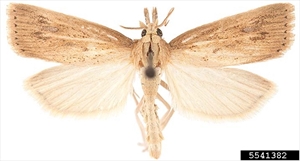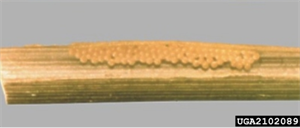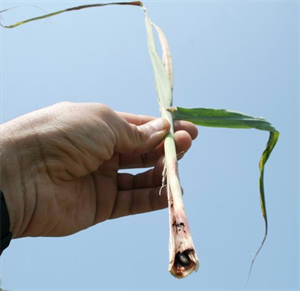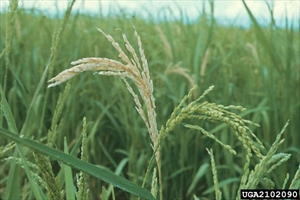Striped rice stem borer; it is also known as the Asiatic rice borer.
Pacific Pests, Pathogens and Weeds - Online edition
Pacific Pests, Pathogens & Weeds
Rice striped stem borer (412)
Chilo suppressalis. A moth in the Crambidae.
South, East and Southeast Asia, North America (Hawaii), Europe, Oceania. It is recorded from Australia, and Papua New Guinea.
Rice, sorghum and maize are major hosts, but it is also found on sugarcane, millet, and many wild grasses.
The larvae is a serious pest of rice, more under temperate and sub-tropical than tropical conditions. The larvae feed on the stems causing similar symptoms to other rice stem borers (see Fact Sheets nos. 408, 409, 410, 411). The larvae tunnel into the stems, through the internodes towards the base of the plant, causing stems to wilt and die, a condition known as 'deadheart'. The stems are easily pulled out (Photo 4). Feeding at the base of the panicles may prevent emergence or result in white unfilled grain of those that have emerged, a symptom called 'whitehead' (Photo 5).
Eggs are scale-like, white turning yellow as they mature, up to 60 in several rows on the leaves, sometimes on the leaf sheaths (Photo 3). Early larvae, greyish-white with black heads, remaining together; later larvae are yellowish, with five purple to brown longitudinal stripes, and brown heads, up to 25 mm long. They disperse to nearby plants, often using silken threads. Pupae are brown, and pupation takes place in the stem; the larvae prepare an exist hole for adults emergence.
Adult males have wingspans of 20-30 mm, slightly larger in females (Photos 1&2). Forewings are yellowish-brown, with dark flecks, and a marginal row of black dots. The hindwings are whitish. They are nocturnal. The entire life cycle is 35-60 days in the tropics. Spread is by active flight and/or on the wind. Unlike other Chilo species it is adapted to temperate climates.
CABI states that this is one of the most important pests of rice in East Asia, India and Indonesia. It is a threat to Africa. In Asia, Scirpophaga incertulas (rice yellow stem borer) and Chilo suppressalis are responsible for a steady annual damage of 5-10% of the rice crop, with occasional localized outbreaks of up to 60%. There are reported declining populations in Japan, Korea and Taiwan, possibly due to early planting, high-tillering varieties, pesticides use, early harvesting and mechanisation.
Look for deadhearts and whiteheads at the vegetative and flowering stages, respectively. Look for frass, larvae and pupae in the stems. Because of similarity with other stem borer species attacking rice, identifications should be done by taxonomists with expertise in the Lepidopteran pests of rice.
BIOSECURITY
Countries not yet infested by the striped rice stem borer should consider all likely pathways for entry, and apply quarantine measures accordingly. It is a major pest of rice, in particular. Many countries throughout Africa, South America and also Oceania are at risk. Pathways of introduction are likely to be via produce contaminated by pieces of stem of the hosts infested with larvae or pupae.
NATURAL ENEMIES
In general, the rice white stem borer is parasitised and predated by the same natural enemies as other rice stem borers. The tachnid fly, Paratheresia claripalpis, is used in Malaysia, and Eriborus sinicus (and ichneumonid) in Asia and Hawaii.
CULTURAL CONTROL
Before planting:
- Prepare the land thoroughly ensuring destruction of larvae and pupae in stubble. Flooding, harrowing or ploughing destroy larvae or pupae in stubble and straw, or volunteer rice plants.
- Handpick and destroy egg masses in the nursery.
- Before transplanting, cut the tip of the leaves to prevent carry-over from the nursery to the field.
- Plant at high density to compensate for damage that may occur.
- Rotate two crops of rice and then fallow the land, or plant maize, soybean or peanut.
During growth:
- Weed as soon as required to promote good crop growth.
- Cut out the stems with deadhearts and remove from the field. Destroy the larva or burn the stalk. Note this is labour intensive and not very effective as the pest may already have left.
- Apply nitrogen fertilizer in split applications: check local recommendations for rates and timing. Fertilizer helps plants infested during the tillering stage to recover from the damage.
After harvest:
- Harvest crops at ground level to remove the larvae in the stubble beforre they move to the lower part of the plant to diapause.
- Plough remaining rice stubble into the soil to kill larvae and pupae, and avoid leaving unharvested plants. Alternatively, irrigate the field, if possible.
RESISTANT VARIETIES
Modern rice varieties that are relatively thin-stemmed, short, high tillering, and early maturing, may result in less damage from stem borers generally. This aspect is important as well-grown, vigorous crops can withstand 20% deadhearts and 10% whiteheads before yield is affected. Semi-dwarf varieties (IR20 and IR26) are moderately resistant.
CHEMICAL CONTROL
The use of insecticides risks destroying natural enemies. Use only as a last resort:
- Use abamectin, a natural fermentation product from a bacterium. Other biorational chemicals are known, for instance, tebufenozide, which disrupts moulting of larvae.
- In Fiji, diazinon and bifenthrin are recommended for (unspecified) stem borers.
- Chlorpyrifos and fipronil, have also been recommended (for all stem borers), but note that chlorpyrifos is an organophosphate insecticide, and is a potent nerve agent; the World Health Organization (WHO) considers chlorpyrifos to be moderately hazardous (Class II). The use of fipronil is under review in Australia by the APVMA because of environmental concerns. A report is expected in 2020. Reviews on the use of chlorpyrifos are on-going in Europe, USA and Australia.
- All synthetic products are likely to reduce the impact of natural predators and parasitoids against this moth, and can only be recommended as a last resort.
____________________
When using a pesticide, always wear protective clothing and follow the instructions on the product label, such as dosage, timing of application, and pre-harvest interval. Recommendations will vary with the crop and system of cultivation. Expert advice on the most appropriate pesticide to use should always be sought from local agricultural authorities.
AUTHOR Grahame Jackson
Information (and Photo 4) from Rice Knowledge Bank. IRRI. (http://www.knowledgebank.irri.org/training/fact-sheets/pest-management/insects/item/stem-borer); and CABI (2019) Chilo suppressalis (striped rice stem borer). Crop Protection Compendium. (https://www.cabi.org/cpc/datasheet/12855); and Pathak MD, Khan ZR (1994) Insect Pests of Rice. IRRI/ICIPE.(http://books.irri.org/9712200280_content.pdf); and from Chilo suppressalis. Wikipedia. (https://en.wikipedia.org/wiki/Chilo_suppressalis). Photo 1 Asiatic rice borer (Chilo suppressalis) Todd Gilligan, Screening Aids, USDA APHIS PPQ, Bugwood.org. Photos 2,3&4 Asiatic rice borer (Chilo suppressalis) International Rice Research Institute, Bugwood.org.
Produced with support from the Australian Centre for International Agricultural Research under project HORT/2016/185: Responding to emerging pest and disease threats to horticulture in the Pacific islands, implemented by the University of Queensland and the Secretariat of the Pacific Community.








